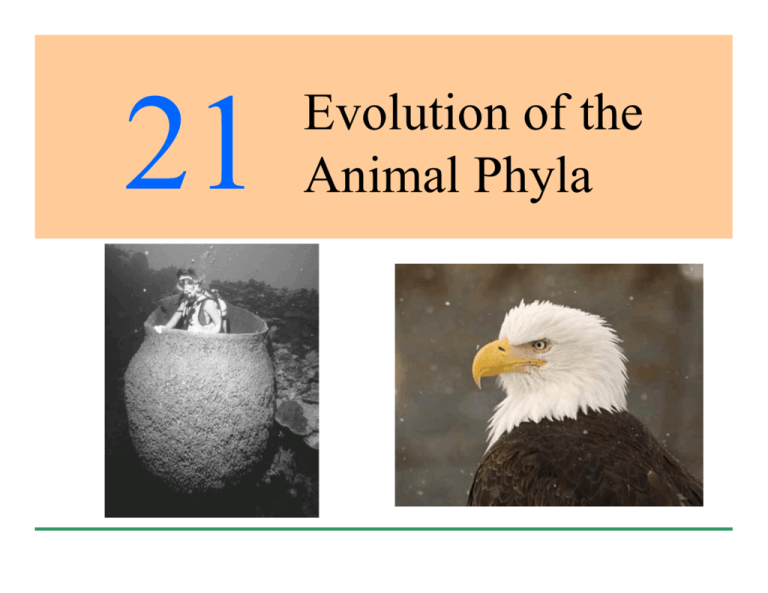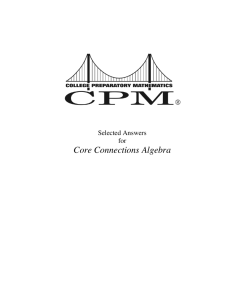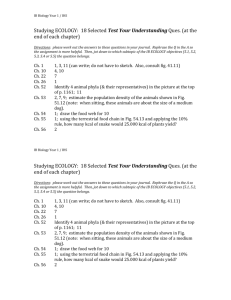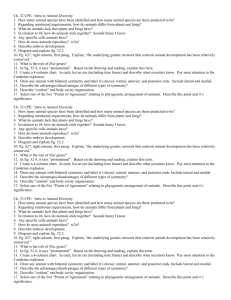Evolution of the Animal Phyla
advertisement

Evolution of the Animal Phyla 21.1 General Features of Animals All animals are multicellular heterotrophs They all require oxygen for respiration Animals are diverse in form There are ~ 10 million living species ~ 99% are invertebrates (lacking a backbone) ~ 1% are vertebrates (possessing a backbone) There are about 36 phyla Most occur in the sea Three phyla dominate life on land Arthropoda; Mollusca; Chordata Animals lack cell walls They are usually quite flexible Animals are mobile They move more rapidly and in more complex ways than members of other kingdoms Most animals reproduce sexually An animal develops from a zygote by a characteristic process of embryonic development Morula Æ Blastula Æ Gastrula Details vary widely between phyla Provide clues to evolutionary relatedness 21.2 The Animal Family Tree Taxonomists have traditionally created phylogenies (family trees) based on two main criteria Anatomical features Embryonic development Fig. 21.3 Parazoa (“beside animals”) Lack tissues and symmetry Eumetazoa (“true animals”) Possess tissues and symmetry Eumetazoa have two branches Radiata Have radial symmetry Bilateria Have bilateral symmetry Fig. 21.3 Fig. 21.2 Evolutionary trends among the animals “Evo-Devo” and Roots of the Animal Family Tree Nearly all the major animal body plans can be seen in Cambrian rocks dating from 543-525 mya Biologists have long debated what caused this Cambrian explosion of animal diversity Proposed reasons include Emergence of predatory lifestyles Geological factors, such as the buildup of minerals in the oceans “Evo-Devo” and Roots of the Animal Family Tree Another idea…from the Cambrian explosion comes the new field of “evo-devo” A synthesis of evolutionary and devolepmental biology Much of the variation in animal body plan is associated with changes in the Hox gene complex Family of genes controlling animal development 21.3 Sponges: Animals Without Tissues The Kingdom Animalia consists of two subkingdoms Parazoa Animals that lack symmetry and possess neither tissues nor organs 1 phylum: Porifera Eumetazoa Animals that have symmetry and in most cases tissues and organs About 35 phyla Sponges are the simplest animals Bodies consist of little more than masses of specialized cells embedded in a gel-like matrix Fig. 21.7 Fig. 21.8 The choanocytes of sponges very closely resemble a kind of protist called choanoflagellates These may be the ancestors of all animals 21.4 Cnidarians: Tissues Lead to Greater Specialization The structure of eumetazoans is much more complex than that of sponges Radially symmetric eumetazoans form two distinct embryonic layers An outer ectoderm Æ epidermis An inner endoderm Æ gastrodermis A jelly-like layer called the mesoglea forms between the epidermis and gastrodermis Cnidaria Hydra Corals Fig. 21.9 Jellyfish Sea anemone Cnidarians Carnivores that capture their prey with tentacles Bear unique stinging cells called cnidocytes Contain a small but powerful harpoon called a nematocyst A major evolutionary innovation among the radiates is extracellular digestion of food In radiates, digestion begins in the gastrovascular cavity Fig. 21.10 Cnidarians have two basic body forms Medusae Free-floating, gelatinous and often umbrella-shaped Polyps Cylindrical, pipeshaped and usually attached to a rock Fig. 21.11 Cnidarians may exist exclusively as either/or Others alternate between the two phases 21.5 Solid Worms: Bilateral Symmetry Radiates are radially symmetrical Have a regular arrangement of parts around a central axis All other eumetazoans are bilaterally symmetrical Have right and left halves that are mirror images Dorsal (top) vs. Ventral (bottom) Anterior (front) vs. Posterior (back) Fig. 21.13 Bilaterally symmetrical animals have evolved a definite head end, a process called cephalization Solid worms are the simplest of all bilaterally symmetrical animals Nervous system Ectoderm Mesoderm Endoderm Lack internal cavities, except for digestive tract Acoelomate + Fig. 21.14 Flatworms Members of Platyhelminthes The largest phylum of solid worms Simplest animals in which organs occur Some species are free-living Most species are parasitic Tapeworms Fig. 21.15a Flukes Many require two or more hosts to complete their life cycle Planaria Fig. 21.16 Life cycle of the human liver fluke, Clonorchis sinensis Fig. 21.17







